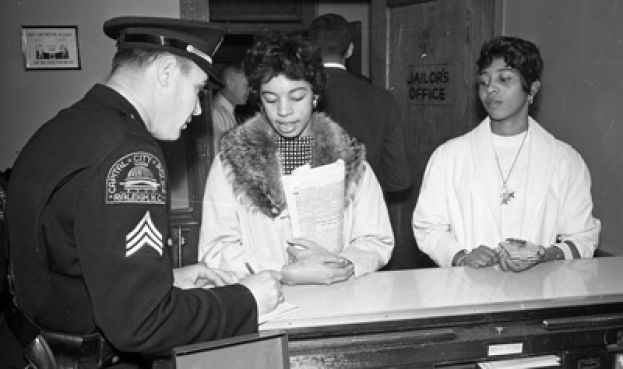Protesting for Change: Alumni recall their involvement in the civil rights movement

Editor’s note: As we celebrate Black History Month, we are reminded of the amazing contributions of African Americans throughout history. They come from all over the world — old and young — and they fought for the progress we see today. Among those who made their mark on history is a group of Saint Augustine’s University alumni who dared to take a stand against Jim Crow law. In 2010, a few of these alumni gathered at the North Carolina Museum of History to share their memories. In honor of Black History Month, the article from the 2010 panel is reprinted here.
On February 1, 1960, when four students from North Carolina Agricultural and Technical University staged a sit-in at the Woolworth’s lunch counter in downtown Greensboro, they started a movement for equality that caught the attention of the nation and inspired a chain of similar protests throughout the South.
Nine days after the sit-ins in Greensboro, Saint Augustine’s College and Shaw University students began planning their own protest. 1963 graduate Barbara Woodhouse was an 18-year-old freshman at Saint Augustine’s College at the time. She recently shared her memories of the protest during a panel discussion at the North Carolina Museum of History.
Woodhouse was walking across the campus quadrangle on February 10, 1960, when she heard other students talking about getting involved in the lunch room sit-ins. That evening, she went to a meeting to hear about what was planned.
“I was very nervous about even the idea of participating in a movement,” Woodhouse said.
Even though she was nervous, Woodhouse joined the other student protesters on the quad the next day, Feb. 11, 1960. Male students served as leaders, Woodhouse said. The football team provided backup.
“We were told to dress nicely and carry a book or newspaper,” Woodhouse said. They were also told, “If you are attacked, do not respond.”
The students planned to go sit at the lunch counter at Woolworth’s in Cameron Village, but with protests rising up in locations throughout the state and region, the business had locked its doors as a precaution before they arrived.
“Students walked up and down the sidewalk,” Woodhouse said. “The store manager said, ‘I want you students to leave.’ We were told we were trespassing. The students continued to move.”
After repeated warnings from the Woolworth’s manager, the police were called. All 13 students were arrested. They were taken to the Wake County Jail on Fayetteville Street and charged with trespassing.
“When we got back to Saint Augustine’s, all the students were excited,” Woodhouse said. “We kind of took the stand of low profile.”
Woodhouse said a friend joked that she got arrested because she was wearing a coat with a fur collar.
Although Woodhouse’s college friends and classmates were excited about the protest, back home in Virginia Beach, Va., her father was not at all pleased that his daughter had gotten mixed up in a demonstration that resulted in her getting arrested.
“I went home for Easter break. While there, a representative from the sheriff’s department showed up at my home and said, ‘I have a warrant for the arrest of Barbara Woodhouse,'” she said. “My father hit the ceiling. He said, ‘I’m not struggling to send you to college for you to get arrested.'”
Woodhouse was forced to return to Raleigh immediately. When she went to court, all the charges were dismissed, and she knew she should keep a low profile from that day forward.
Those who participated in the civil rights protests of the late 1950s and 60s talked about how carefully protesters were chosen for particular demonstrations. Those who had been arrested before couldn’t participate.
“I was there demonstrating, but I never got a chance to sit down. We had designated sit-downers,” said Dr. Herman Thomas, who coordinated demonstrators for the sit-ins in Greensboro. In 1956, Thomas was arrested during an unsuccessful attempt to integrate the Swain County school system.
Thomas, a retired Shaw University administrator, said sit-in participants also had to meet the mark academically.
“We had to make sure that everyone who participated in the sit-ins did not succumb to academic failure,” Thomas said. “You had to complete your classes.”
Not all protests ended with arrests. 1959 Saint Augustine’s College graduate David O. Sanders said during one protest, students planned to go to the lunch counters downtown – S. H. Kress, Woolworth’s and Walgreens. They all went at 1 p.m.
“Everywhere we went, we sat down,” Sanders said. “We stayed as long as we chose to stay, and there were never any arrests.”
Sanders also remembers a time when Dr. Prezell R. Robinson, Saint Augustine’s College president emeritus, and Dr. James Cheek, former president at Shaw University, assembled students at Shaw to discuss civil rights efforts.
“Students came out of Shaw in droves and marched on Fayetteville Street,” Sanders said. “The message got out.”
Not long after the sit-ins in February 1960, the Student Nonviolent Coordinating Committee (SNCC) was formed during a conference at Shaw University. Sanders also recalled Dr. Martin Luther King Jr. holding a rally at Broughton High School.
“Raleigh, along with other cities, helped to lead the nation through a crisis,” Sanders said.
Photo: Pictured are Barbara Woodhouse and Gloria Gardner, also a St. Aug graduate.
On the Web:
http://web.co.wake.nc.us/lee/vf/cr/demo/sitins/ral/news/19600212sspl/19600212sspl.pdf
http://www.newraleigh.com/articles/archive/black-history-month-the-woolworths-sit-ins/
http://www.raleighcitymuseum.org/exhibits/let_us_march_on.shtml
